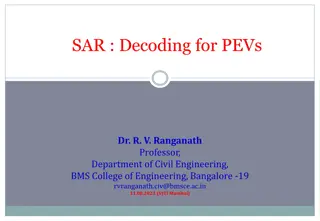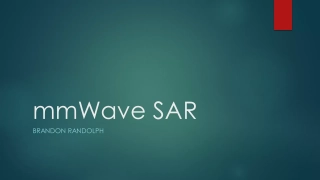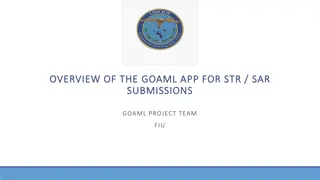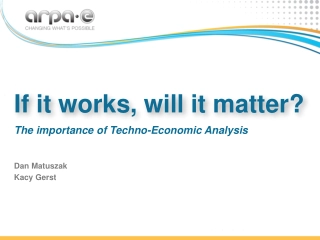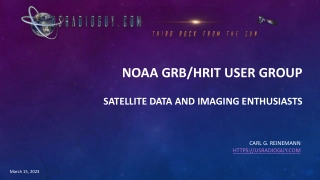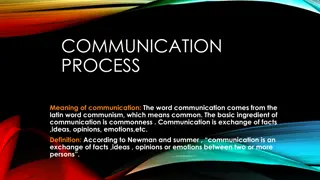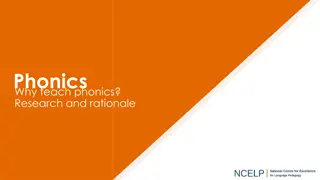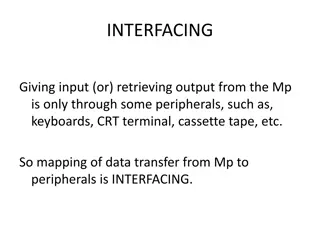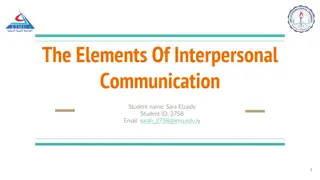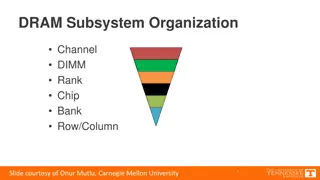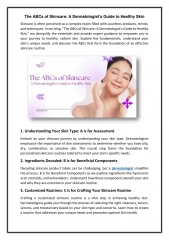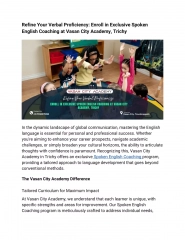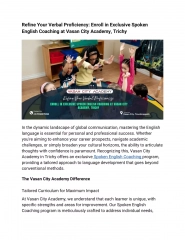SAR : Decoding for PEVs
This document provides detailed information on SAR decoding for Program Educational Videos (PEVs) at BMS College of Engineering in Bangalore. It covers key criteria such as institutional information, program-level details, faculty contributions, student performance, facilities, and continuous improvement. The SAR context ensures preparedness and presents a clear program status for evaluation teams during NBA visits.
Download Presentation
Please find below an Image/Link to download the presentation.
The content on the website is provided AS IS for your information and personal use only. It may not be sold, licensed, or shared on other websites without obtaining consent from the author. Download presentation by click this link. If you encounter any issues during the download, it is possible that the publisher has removed the file from their server.
Presentation Transcript
SAR : Decoding for PEVs Dr. R. V. Ranganath Professor, Department of Civil Engineering, BMS College of Engineering, Bangalore -19 rvranganath.civ@bmsce.ac.in 16.08.2023 (IIT KGP)
SAR Context Provides preparedness status at I/P level for the NBA visit, Provides the first impression about the I/P to the evaluation team, Presents crisp program status to the evaluation team and addresses process and the extent to which, a program meets each criterion, Provides documented evidences, which the evaluation team maps/matches with the visual /oral evidences during the visit.
SAR Contents PART A PART B Criteria No. 1 2 3 4 5 6 7 Institutional Information Criteria Summary Program Level Criteria Vision, Mission and Program Educational Objectives Program Curriculum and Teaching-Learning Processes Course Outcomes and Program Outcomes Students Performance Faculty Information and Contributions Facilities and Technical Support Continuous Improvement
Contd. Criteria No. 8 9 Institute Level Criteria First Year Academics Student Support Systems Governance, Resources Declaration by the Institution Program Outcomes (POs) & Program Specific Outcomes (PSOs) Institutional Support and Financial 10 PART C Annexure-I
PART B: Criteria Summary Tier 2 Tier 1 780
PART B: Criteria Summary Tier 1 Tier 2 220
CRITERION-1: Vision, Missionand Program Educational Objectives (PEOs) 1.1. State the Vision and Mission of the Department and Institute.(5) Vision statement typically indicates aspirations and Mission statement states the broad approach to achieve aspirations Should be written in a simple language, easy to communicate and should define objectives which are out of reach in the present context Department Vision and Mission statements shall be consistent with the Institute Vision and Mission statements 1
Vision and Mission Statements (as per NBAdocument) Vision is a futuristic statement that the institution would like to achieve over a long period of time, and Mission is the means by which it proposes to move toward the stated Vision Example.. Action verb ?? Verb Vision: To emerge as one of the nation s finest Institutions in the field of Technical Education and Research through focused, effective and sustained monitoring of its programmes and resources. Mission: To develop high quality professionals ingrained in ethics, wisdom and creativity for the betterment of the society.
Department Vision and Mission Statements (Sample) Vision: To be an excellent centre for imparting quality higher education in Civil Engineering for a constantly changing societal needs with credibility, integrity and ethical standards. Mission: Accomplish excellence in curricular, co-curricular activities with a committed faculty through quality teaching and research which creates technically competent and dedicated civil engineers to serve their surroundings with pride. PIs: 1. Excellence in Curricular and Co-curricular activities 2. Quality teaching and research,,,, 3. Technically competent engineers,,,
Evaluation A. Availability of the Vision and Mission statements of the Department (1) B. Appropriateness/Relevance of the Statements (2) C. Consistency of the Department statements with the Institute statements (2) (Here Institute Vision and Mission statements have been asked to ensure consistency with the department Vision and Mission statements; the assessment of the Institute Vision and Mission will be done in Criterion 10) Exhibits/Context to be Observed/Assessed: A. Vision & Mission Statements B. Correctness from definition perspective C. Consistency between Institute and Department statements
Contd. 1.2. State the Program Educational Objectives (PEOs) (5) Define the PEOs under the following broad categories: Preparation :Employment/Higher studies i. ii. Core competence : Discipline knowledge iii. Professionalism : Professional value - knowledge development iv. Life long learning : Environment A. Listing of the Program Educational Objectives (3 to 5) of the program under consideration (5) Exhibits/Context to be Observed/Assessed: A. Availability & correctness of the PEOs statements
PEOs (Samples) Graduates after 3-5 years, will be able to: PEO1: Compete on a global platform to pursue their professional career in Electrical Engineering and allied disciplines. PEO2: Pursue higher education and/or engage in continuous up gradation of their professional skills. PEO3: Communicate effectively while working in diverse team. PEO4: Demonstrate concern for society and environment.
Contd. 1.3. Indicate where the Vision, Mission and PEOs are published and disseminated among stakeholders(PEOs) (10) Availability on Institute website under relevant program link Availability at department notice boards Department website, if available Availability in department level documents Documentary evidence A. Adequacy in respect of publication & dissemination (2) B. Process of dissemination among stakeholders (2) C. Extent of awareness of Vision, Mission and PEOs among the stakeholder (6)
Contd. Exhibits/Context to be Observed/Assessed: A. Adequacy Department Vision, Mission and PEOs: Availability on Institute website under relevant program link; Availability at department notice boards, HoD Chamber, department website, if Available; Availability in department level documents/course of study B. Process of dissemination Documentary evidence to indicate the process which ensures awareness among internal and external stakeholders with effective process implementation C. Extent of Awareness Based on interaction with internal and external stakeholders
Contd. 1.4. State the process for defining the Vision and Mission of the Department and PEOs of the program (25) Process to ensure: Effective participation of Stakeholders Effective Process implementation Documentary evidence A. Description of process involved in defining the Vision, Mission of the Department (10) B. Description of process involved in defining the PEOs of the program (15) Exhibits/Context to be Observed/Assessed: Documentary evidence to indicate the process which ensures effective participation of internal and external department stakeholders with effective process implementation
Processes for PEOs Feedback collecting stakeholders A process by which PEOs are created and reviewed periodically A process to evaluate to what extent attained. format data for from PEOs are
Contd. 1.5. Establish consistency of PEOs with Mission of the Department (15) Generate a Mission of the Department PEOs matrix with justification and rationale of the mapping: PEO Statements PEO 1 PEO 2 PEO 3 PEO 4 M1 M2 Mn Note: M1, M2, . . Mn are distinct elements of Mission statement. Enter correlation levels 1, 2 or 3 as defined below: 1: Slight (Low) 2: Moderate (Medium) 3: Substantial (High) If there is no correlation, put -
Mission of the Department: M1: Make competent Civil Engineers with high level of professional, moral and ethical values M2:Impart highest standards in theoretical as well as practical knowledge and skill set M3:Establish Center of Excellence in major areas of Civil Engineering to respond to the current and future needs of the industry PEO1: Graduates will have successful career in the field of Civil Engineering PEO2: Graduates will respond to growing demands of society through professional and ethical practices PEO3: Graduates will pursue lifelong learning including higher studies in the field of Civil Engineering What is Expected here ? Establish consistency of PEOs with Mission of the Department (15) Generate a Mission of the Department PEOs matrix with justification and rationale of the mapping PEO Statements M1 M2 Mn PEO 1 PEO 2 PEO 3 3/2/1 ? 3/2/1 ? 3/2/1 ?
A. Preparation of a matrix of PEOs and elements of Mission statement (5) B. Consistency/justification of co-relation parameters of the above matrix (10) Exhibits/Context to be Observed/Assessed: A. Availability of a matrix having PEOs and Mission elements B. Justification for each of the elements mapped in the matrix
CRITERION-2: Program Curriculum and Teaching Learning Processes (TLP) 2.1. Program Curriculum (20) 2.1.1. State the process used to identify extent of compliance of the University curriculum for attaining the Program Outcomes and Program Specific Outcomes as mentioned in Annexure-I. Also mention the identified curricular gaps, if any (10) State the process details Mention identified curricular gaps Extent of compliance Exhibits/Context to be Observed/Assessed: A. Documentary evidence to indicate the process which ensures mapping/compliance of University Curriculum with the POs & PSOs; Identification of gaps; if any. B. Identified Curricular gaps and its Appropriateness
Contd. 2.1.2. State the delivery details of the content beyond the syllabus for the attainment of POs & PSOs (10) Details of the following for the attainment of POs & PSOs Additional course Learning material/Content Laboratory experiments Projects etc. Institute to provide inputs to the Affiliating University regarding curricular gaps and possible addition of new content/add-on courses in the curriculum to better attain program outcome(s)
Curriculum-Tier 2 Analyze the University Curriculum Determine the Gaps in Attainment of POs Design Extra {modules} I {Assessments} to Bridge these gaps Could need a few iterations (Ex; Say, Financial Management course or any activities related to PO11 are missing totally or insufficient through what is provided in Univ curriculum, Then, what you do ?)
Analysis may indicate that not all POs are Attainable with the Given Curriculum. May need some additional modules and Design of In-Sem evaluation and assessment to take care of the gaps. A record of all this work is needed.
Steps taken to get identified gaps included in the curriculum. (e.g. letter to university/BOS) (2) A. Delivery details of content beyond syllabus (5) B. Mapping of content beyond syllabus with the POs & PSOs (3) C. Exhibits/Context to be Observed/Assessed: A. Documentary evidence of steps taken at regular interval B. Delivered details documentary evidence for at least one sample per assessment year to be verified C. Availability and appropriateness of Mapping table between contents delivered and Program outcomes/Program specific outcomes (Course outcomes)
Contd. 2.2. Teaching-Learning Processes. 2.2.1. Describe Processes followed to improve quality of Teaching and Learning (25) Processes may include adherence to academic calendar and implementation of pedagogical initiatives such as - Real life examples Collaborative learning Quality of laboratory experience with regard to conducting experiments Recording observations Analysis of data etc. Encouraging bright students Assisting weak students etc. ICT supported learning Interactive classrooms
Adherence to Academic Calendar (3) A. Use of various instructional methods and pedagogical initiatives (3) B. Methodologies to support weak students and encourage bright students(4) C. Quality of classroom teaching (Observation in a Class) (3) D. Conduct of experiments (Observation in Lab) (3) E. Continuous Assessment in the laboratory (3) F. Student feedback of teaching learning process and actions taken (6) G. Exhibits/Context to be Observed/Assessed: A. Availability of Academic Calendar based on University academic calendar and its effective compliance B. Documentary evidence to support implementation of pedagogical initiatives such as real life examples, collaborative learning, ICT supported learning, interactive class rooms etc. C. Guidelines to identify weak and bright students; post identification actions taken; impact observed D. Class room ambience; efforts to keep students engaged (also to be verified during interaction with the students) E. Quality of laboratory experience with respect to conducting, recording observations, analysis etc.(also to be verified during interaction with the students) F. Internal Semester examination and internal marks thereof, Practical record books, each experiment assessment, final marks based on assessment of all the experiments and other assessments; if any G. Feedback format, frequency, analysis and actions taken (also to be verified during interaction with students)
Contd. 2.2.2. Quality of internal semester Question papers, Assignments and Evaluation.(20) Mention the initiatives, Implementation details and analysis of learning levels related to a. Quality of Semester Question papers b. Assignments c. Evaluation d. Relevance to COs Exhibits/Context to be Observed/Assessed: A. Process of internal semester question paper setting, model answers, evaluation and its compliance B. Question paper validation to ensure desired standard from outcome attainment perspective as well as learning levels perspective C. Mapping of questions with the Course outcomes Course files D. Assignments to promote self-learning, survey of contents from multiple sources, assignment evaluation and feedback to the students, mapping with the Cos
Contd. 2.2.3. Quality of Student Projects (25) Consideration to factors including, but not limited to Environment & Safety Ethics Cost Type (application, product, research, review etc.) Standards Processes related to project identification, allotment, continuous monitoring and evaluation Demonstration of working prototype sand enhancing the relevance of projects. Mention Implementation details including details of POs and PSOs addressed with justification Look for evidence of solving Complex Engineering Problems/Activities. Exhibits/Context to be Observed/Assessed: A. Projects identification and guide allocation Process B. Projects classification (application, product, research, review etc.) consideration to factors such as environment, safety, ethics, cost, standards and mapping with program outcomes and program specific outcomes C. Continuous monitoring mechanism and evaluation D. Methodology (Appropriately documented) to assess individual contribution/ understanding of the project as well as collective contribution/understanding E. Based on Projects demonstration F. Quality of place (host) where the paper has been published /quality of competition in which award has been won
Contd. 2.2.4. Initiatives related to industry interaction (15) Industry supported laboratories. Industry involvement in the program design and partial delivery of any regular courses for students. Impact analysis of industry institute interaction and actions taken thereof Exhibits/Context to be Observed/Assessed: A. Type of Industries, Type of Labs, objectives, utilization and effectiveness B. Documentary evidence C. Analysis and actions taken thereof 2.2.5. Initiatives related to industry internship/summer training (15) Industrial training/tours for students. Industrial / internship / summer training of more than two weeks and post training Assessment. Impact analysis of industrial training. Student feedback on initiatives
Exhibits/Context to be Observed/Assessed: A. & B. Type of Industries, planned or non-planned activity, objectives clearly defined, no. of students participated, relevant area of training, visit report documented C.& D. Impact analysis and feedback format, analysis and actions taken (also to be verified during interaction with students)
CRITERION 3:Course Outcomes and Program Outcomes 3.1. Establish the correlation between the Courses and the Program Outcomes (POs) and Program Specific Outcomes (PSOs) 3.1.1. Course Outcomes (COs) SARshould include course outcomes of One course/Semester (3rd to 8th) of study, however, should be prepared for all courses and made available as evidence Exhibits/Context to be Observed/Assessed: A. Appropriateness of the statements shall be seen for atleast one course each from 2nd, 3rd and final year of study
Program Outcomes POs are statements about the knowledge, skills and attitudes (attributes) the graduate of a formal engineering program should have. Profile of the Graduates reached through POs - Target POs are defined Agencies of the country (NBAin India) Defining these is the Starting Point by Accreditation
Program Outcomes (POs) 1. Engineering Knowledge: Apply the knowledge of mathematics, science, engineering fundamentals, and an engineering specialization to the solution of complex engineering problems. 2. Problem Analysis: Identify, formulate, review research literature, and analyze complex engineering problems reaching substantiated conclusions using first principles of mathematics, natural sciences, and engineering sciences. 3. Design/Development of Solutions: Design solutions for complex engineering problems and design system components or processes that meet the specified needs with appropriate consideration for the public health and safety, and the cultural, societal, and environmental considerations 4. Conduct Investigations of Complex Problems: Use research-based knowledge and research methods including design of experiments, analysis and interpretation of data, and synthesis of the information to provide valid conclusions.
Conti 5. Modern Tool Usage: Create, select, and apply appropriate techniques, resources, and modern engineering and IT tools including prediction and modeling to complex engineering activities with an understanding of the limitations. 6. The Engineer and Society: Apply reasoning informed by the contextual knowledge to assess societal, health, safety, legal and cultural issues and the consequent responsibilities relevant to the professional engineering practice. 7. Environment and Sustainability: Understand the impact of the professional engineering solutions in societal and environmental contexts, and demonstrate the knowledge of, and need for sustainable development. 8. Ethics: Apply ethical principles and commit to professional ethics and responsibilities and norms of the engineering practice.
Conti Individual and Team Work: Function effectively as an individual, and as a member or leader in diverse teams, and in multidisciplinary settings. 10. Communication: Communicate engineering activities with the engineering community and with society at large, such as, being able to comprehend and write effective reports and design documentation, make effective presentations, and give and receive clear instructions. 11. Project Management and Finance: Demonstrate knowledge and understanding of the engineering and management principles and apply these to one s own work, as a member and leader in a team, to manage projects and in multidisciplinary environments. 12. Life-long Learning: Recognize the need for, and have the preparation and ability to engage in independent and lifelong learning in the broadest context of technological change. 9. effectively on complex
Washington Accord Graduate Attributes (Revised Version 4.0 Vis-a-Vis Existing Version 3.0) Differentiating Characteristic GAPC 4.0 for Washington Accord Graduate WA1: Apply knowledge of mathematics, natural science, computing and engineering fundamentals and an engineering specialization as specified in WK1 to WK4 respectively to develop the solution of complex engineering problems. WA2: Identify, formulate, research literature and analyse complex engineering problems reaching substantiated conclusions using first principles of mathematics, natural sciences and engineering sciences with holistic considerations for sustainable development. (WK1 to WK4) GAPC 3.0 for Washington Accord Graduate WA1: Apply knowledge of mathematics, natural science, engineering fundamentals and an engineering specialization as specified in WK1 to WK4 respectively to the solution of complex engineering problems. Engineering Knowledge: Breadth, depth and type of knowledge, both theoretical and practical WA2: Identify, formulate, research literature and analyse complex engineering problems reaching substantiated conclusions using first principles of mathematics, natural sciences and engineering sciences. (WK1 to WK4) Problem Analysis: Complexity of analysis Design/ development of solutions: Breadth and uniqueness of engineering problems i.e. the extent to which problems are original and to where solutions have not previously been identified or codified WA3: Design creative solutions for complex engineering problems and design systems, components or processes to meet identified specified needs with appropriate consideration for public health and safety, whole-life cost, net zero carbon, as well as resource, cultural, societal, and environmental considerations as required. (WK5) WA3: Design solutions for complex engineering problems and design systems, components or processes that meet specified needs with appropriate consideration for public health and safety, cultural, societal, and environmental considerations. (WK5) WA4: Conduct investigations of complex engineering problems using research based knowledge(WK8) methods including research- based knowledge, design of experiments, analysis and interpretation of data, and synthesis of information to provide valid conclusions (WK8) WA4: Conduct investigations of complex problems using research-based knowledge (WK8) and research methods including design of experiments, analysis and interpretation of data, and synthesis of information to provide valid conclusions. Investigation: Breadth and depth of investigation and experimentation WA5: Create, select and apply, and recognize limitations of appropriate techniques, resources, and modern engineering and IT tools, including prediction and modelling, to complex engineering problems with an understanding of the limitations (WK2 and WK6) WA5: Create, select and apply appropriate techniques, resources, and modern engineering and IT tools, including prediction and modelling, to complex engineering problems, with an understanding of the limitations. (WK6) Modern Tool Usage: Level of understanding of the appropriateness of technologies and various tools WA6: When solving complex engineering problems, analyze and evaluate sustainable development impacts* to: society, the economy, sustainability, health and safety, legal frameworks, and the environment (WK1, WK5, and WK7) WA6: Apply reasoning informed by contextual knowledge to assess societal, health, safety, legal and cultural issues and the consequent responsibilities relevant to professional engineering practice and solutions to complex engineering problems. (WK7) The Engineer and the World Society: Level of knowledge and responsibility for sustainable development Continued .
Differentiating Characteristic GAPC 4.0 for Washington Accord Graduate GAPC 3.0 for Washington Accord Graduate WA7: Understand and evaluate the sustainability and impact of professional engineering work in the solution of complex engineering problems in human, cultural, economic, social etal and environmental contexts. (WK7) WA7: Understand and evaluate the sustainability and impact of professional engineering work in the solution of complex engineering problems in societal and environmental contexts. (WK7) Human, Social, Economic and Environmental impacts and Sustainability: Type of solutions. WA7: Apply ethical principles and commit to professional ethics and responsibilities and norms of engineering practice and adhere to relevant national and international laws. Demonstrate an understanding of the need for diversity and inclusion (WK9) WA8: Apply ethical principles and commit to professional ethics and responsibilities and norms of engineering practice. (WK7) Ethics: Understanding and level of practice WA8: Function effectively as an individual, and as a member or leader in diverse teams and inclusive teams and in multi-disciplinary, face-to-face, remote and distributed settings (WK9) Individual and Collaborative Team work: Role in and diversity of team WA9: Function effectively as an individual, and as a member or leader in diverse teams and in multi-disciplinary settings. WA9: Communicate effectively and inclusively on complex engineering activities with the engineering community and with society at large, such as being able to comprehend and write effective reports and design documentation, make effective presentations, and give and receive clear instructions taking into account cultural, language, and learning differences. WA10: Communicate effectively on complex engineering activities with the engineering community and with society at large, such as being able to comprehend and write effective reports and design documentation, make effective presentations, and give and receive clear instructions. Communication: Level of communication according to type of activities performed WA11: Demonstrate knowledge and understanding of engineering management principles and economic decision- making and apply these to one s own work, as a member and leader in a team, to manage projects and in multidisciplinary environments. WA10: Apply Demonstrate knowledge and understanding of engineering management principles and economic decision-making and apply these to one s own work, as a member and leader in a team, and to manage projects and in multidisciplinary environments. Project Management and Finance: Level of management required for differing types of activity WA11: Recognize the need for, and have the preparation and ability for i) independent and life-long learning ii) adaptability to new and emerging technologies and iii) critical thinking in the broadest context of technological change (WK8) Lifelong learning: Preparation for and depth of continuing learning. Duration and manner WA12: Recognize the need for, and have the preparation and ability to engage in independent and life-long learning in the broadest context of technological change.
Revised Program Outcomes as per GAPC 4.0 Differentiating Characteristic Engineering Knowledge: Breadth, depth and type of knowledge, both theoretical and practical. Program Outcomes as per GAPC 4.0 PO1: Engineering knowledge: Apply knowledge of mathematics, natural science, computing, engineering fundamentals and an engineering specialization to the solution of complex engineering problems. PO2: Problem analysis: Identify, formulate, research literature, and analyze complex engineering problems reaching substantiated conclusions with consideration for sustainable development. Problem Analysis: Complexity of analysis. Design/ development of solutions: Breadth and uniqueness of engineering problems i.e. the extent to which problems are original and to where solutions have not previously been identified or codified. PO3: Design/development of solutions: Design creative solutions for complex engineering problems and design systems/ components/processes to meet identified needs with consideration for the public health and safety, whole-life cost, net zero carbon, culture, society and environment. Investigation: Breadth and depth of investigation and experimentation PO4: Conduct investigations of complex problems: Conduct investigations of complex problems using research-based knowledge including design of experiments, modelling, analysis & interpretation of data to provide valid conclusions. PO5: Engineering Tool usage: engineering/IT tools, in solving complex engineering problems with an understanding of the associated limitations. Create, select, adapt and apply appropriate technologies/techniques and modern Tool Usage: Level of understanding of the appropriateness of technologies and tools. PO6: Impact of Engineering on Society and the environment: Impact of Engineering on Society and the environment: Analyze societal and environmental aspects of engineering activities for impact on sustainability by understanding interactions between engineering with the economic, social, health, safety, legal, and cultural aspects of society. The Engineer and the World: Level of knowledge and responsibility for sustainable development PO7: Ethics: Apply ethical principles and commit to professional ethics, responsibilities and norms of engineering practice. Ethics: Understanding and level of practice Individual and Collaborative Team work: Role in and diversity of team Communication: Level of communication according to type of activities performed PO8: Team Work and Communication: Work effectively as an individual, and as a member or leader in diverse multi- disciplinary teams. Communicate effectively within the profession and with society at large. Such abilities include reading, writing, speaking and listening, and the ability to comprehend and write effective reports and documentations. PO09: Project management and finance: Apply knowledge and understanding of engineering management principles and economic decision-making in one s own work, as a member/leader in a team, and manage projects in multidisciplinary environments. Project Management and Finance: Level of management required for differing types of activity PO10: Life-long learning: Identify and address needs in a changing world, adapt to new and emerging technologies, develop critical thinking approach in the context of broad technological change by engaging in independent and life-long learning. Lifelong learning: Duration and manner
PROGRAM SPECIFIC OUTCOMES (PSO) These outcomes are specific to a program in addition to NBA defined POs, namely, Civil, Mechanical, Chemical, Computer science etc.,(2-4) ELECTRICAL & ELECTRONICS ENGINEERING At the end of the program, students will have the ability to: PSO1 Develop models, analyze and assess the performance of different types of generation, transmission, distribution and protection mechanisms in power systems. PSO2 Design, develop, analyze and test electrical and electronics systems; deploy control strategies for power electronics related and other applications. PSO3 Measure, analyze, model and control the behavior of electrical quantities associated with constituents of energy or allied systems.



